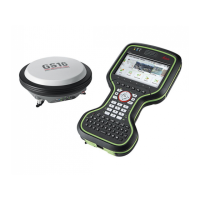GS14/GS16, Operation
46
4.6 Guidelines for Correct Results with GNSS Surveys
Undisturbed
satellite signal
reception
Successful GNSS surveys require undisturbed satellite signal reception, especially at
the instrument which serves as a base. Set up the instrument in locations which are
free of obstructions such as trees, buildings or mountains.
Steady instrument
for static surveys
For static surveys, the instrument must be kept perfectly steady throughout the whole
occupation of a point. Place the instrument on a tripod or pillar.
Centred and
levelled instrument
Centre and level the instrument precisely over the marker.
Power LED
(passive
battery
*2
)
off battery is not connected, flat or the GS14/GS16
is switched off.
flashing green power is 20% - 100%. LED is green for 1 s every
10 s.
flashing red power is less than 20%. LED is red for 1 s every
10 s.
RTK Rover
LED
off GS14/GS16 is in RTK base mode or GS14/GS16 is
switched off.
green GS14/GS16 is in rover mode. No RTK data is being
received at the interface of the communication
device.
flashing green GS14/GS16 is in rover mode. RTK data is being
received at the interface of the communication
device.
RTK Base LED off GS14/GS16 is in RTK rover mode or GS14/GS16 is
switched off.
green GS14/GS16 is in RTK base mode. No RTK data is
being passed to the interface of the communica-
tion device.
flashing green GS14/GS16 is in RTK base mode. Data is being
passed to the interface of the communication
device.
*1 The battery, which currently powers the GS14/GS16 instrument.
*2 Other batteries, which are inserted or connected but are not currently powering
the GS14/GS16 instrument.
IF the is THEN

